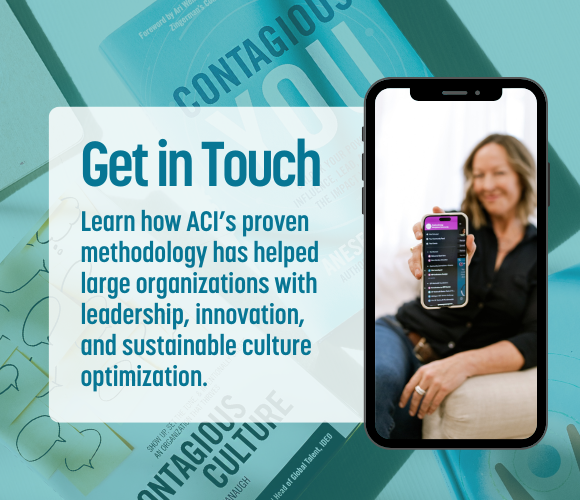There’s a lot in the media about burnout right now; what burnout is, what it costs us, and what to do about it (especially in healthcare where it’s estimated that the prevalence of physician burnout is about twice as high as in the general population). With the World Health Organization (WHO) making it an official medical diagnosis and putting it in their handbook (International Classification of Diseases and Related Health Problems), the conversation around burnout is shifting… it’s “real.”
In my work with leaders and their organizations over the last twenty years, optimizing leadership impact, building positively healthy contagious cultures, and getting in front of (or navigating as needed) burnout and low engagement, I’ve noticed patterns in actions and mindset. (The actions are always the result of mindset.)
I’ve noticed the idea of burnout often being seen as weak (something to be embarrassed about), something to be victim to (something that’s forced upon or done to one), or even seen as an excuse (something people say when they don’t want to work harder). With this, on what could be the preventative side and even an antidote to burnout, self-care is often held as selfish, luxurious, and something to be put on the back burner to address later (the good old “I’ll sleep when I’m dead” philosophy).
This combination of beliefs about self-care and burnout obviously do not serve each other and do not bode well for creating change.
So we have to change the conversation.
It seems we are…
Some 411 on Burnout.
If you’ve missed the news on this, here are some quick highlights:
What is burnout? According to the WHO, burnout is “a syndrome conceptualized as resulting from chronic workplace stress that has not been successfully managed. It is characterized by three dimensions: 1) feelings of energy depletion or exhaustion; 2) increased mental distance from one’s job, or feelings of negativism or cynicism related to one’s job; and 3) reduced professional efficacy. Burn-out refers specifically to phenomena in the occupational context and should not be applied to describe experiences in other areas of life.”
What it costs us: Research has shown that the total annual cost of physician burnout is expected to be higher than $4.6 billion. Physician burnout has been associated with a range of negative consequences, including increased medical errors, poorer clinical outcomes, and lower patient satisfaction. Note that Gallup estimates that actively disengaged employees cost the U.S. $483 billion to $605 billion each year in lost productivity. (In my experience disengagement and burnout are closely related.)
All to say, burnout, disengagement, and all of the above are costing us a ton in resources; time, money, energy, results, impact, and most importantly, the human spirit.
What to do about it: I’ve seen recommendations ranging anywhere from appointing Chief Wellness Officers (CWO), providing more support for people experiencing burnout, improving the efficiency of electronic health records and systems, increasing empathy, making space for the conversation, being more transparent about workloads and the stress that goes with them, creating more “slack” space in peoples’ schedules to get more done, and more.
There’s a ton we can do.
In my opinion, for any of this to work and be sustainable, we have to start with our mindset and relationship to this conversation first.
Response-Ability & Opportunity.
I hold this all as an individual and cultural response-ability. We need to be able to respond and be conscious of our own personal needs and to set ourselves up better for greater health (mentally and physically) and productivity so that we get in front of burnout (or tend to it if we hit it). AND as organizations and leaders fostering healthy cultures, we need to be able to respond (proactively, preferably) to the needs of our people, systems, and structures that are contributing to burnout in the first place.
Not only is this a great response-ability, it’s a huge opportunity. After all, if the results your organization are getting right now are “good,” imagine what happens when people are able to be even more focused on the right things; when they’re feeling good, engaged, and intentional about their impact; and when they have more mental and emotional space to do their magic. Likely even better results, while feeling more energized doing so.
So where do we start?
So many places.
Inside-out, outside-in, and everywhere in between. Inside-out first…
The Decision.
The first thing to be done, before anything, is to make the decision that this truly matters and to decide to do something about it. The more honest and solid the decision, the easier the path and the stronger the result.
Don’t take this decision for granted. In my experience we humans say we have decided to do something, all the time, and really haven’t. (And then we’re shocked and disappointed when it doesn’t happen, often blaming external circumstances or others. If we’re super honest and look back, there’s usually a quiet way in which we did not fully decide. Just think of the last time you “decided” to lose weight, get healthy, or make a relationship better. Were you FULLY IN? If so, it likely happened. If not, there may have been a loophole in that decision.)
So, dig deep. Does THIS topic of burnout and self-care truly matter to you and your organization, and if so, are you truly deciding to do something about it? Whatever it takes? Starting with you first? Are you IN?
If so, you’re halfway there…
It has to start with each of us.
The greatest thing we have any control over in the world is ourselves. And we’re contagious. Our best bet is to BE and MODEL the changes we want to see. So this has to start with each of us individually leaning in, owning it, and addressing it to be a part of the solution. Leadership starts from the inside out. (In a future article I will talk about how we as leaders leading others, and our culture can address this from the outside-in, and for now, let’s each go first and set the tone, shall we?)
Once you have awareness (check!) and you’ve made your decision (check!), you are now in a position of power to start creating change.
Creating Change from the Inside-Out.
I’ve found behavior and culture change to be a “go slow to go fast” animal. Hitting things quick, one-time initiatives, a one-time idea exchange often feels fulfilling in the moment, but rarely unlocks the full potential or livelihood of a sustainable desired shift. So let’s go slow to go fast here.
The approach I use to work with people from the inside-out, to build that sustainable and authentic change, is based upon my core methodology, The IEP Method® (which I write about in CONTAGIOUS CULTURE: Show Up, Set the Tone, and Intentionally Create an Organization That Thrives, McGraw-Hill, 2015). The methodology helps people work from the inside-out in order to show up better for themselves (first) and, of course, others (organically).
I’ve found that when you have a culture of people who are taking ownership for their own Intentional Energetic Presence®, for how they show up at work and in their lives, for how they take care of themselves, and for how they treat others — the outcome is more naturally a healthy positively contagious culture. From here, burnout becomes less of an issue.
Instead of working from the outside-in where initiatives are being imposed upon people or someone is trying to make one do something (often not modeling it themselves), when we work from the inside-out, owning these changes for ourselves first, we create a more congruent and powerful shift. This shift is contagious. The more we show up clear, present, intentional, and as a stand for our own well-being, leadership, and service, the more others will “catch it” and be inspired by it, see it as the new norm, meet us there, and create their own version for themselves.
So let’s try it, going slow to go fast…
Your Intentions, Energy, and Presence, AKA, Your IEP.
Wherever you are at in your leadership journey, your energy levels, and your relationship with burnout, I invite you to explore the following inquires to get started on up-leveling your leadership impact and addressing (or getting in front of) burnout.
- How intentional are you with your time and energy and how you spend it? How good are you at holding boundaries for that time and energy?
- How clear are you on your intentions for impact? Do you know why you go to meetings and what impact you’re there to create? Your purpose for doing the work you do? What is your intention?
- What is your self-care like? Does your self-care practice (i.e. food, exercise, sleep, scheduling, the way you talk to yourself), give you the energy and stamina to do what you want to do? Is the way you treat yourself and your body, life-giving? Are you setting yourself up for success or are you starting below the line before you even engage with your day?
- How present are you? Truly. Are you here, now in this moment with me reading this (or have you checked your phone/email/whatever since you started)? Are you digesting this article in a way that will support you?
- How present are you in the moments throughout your day? Are you IN THE MOMENT (where you can be fully informed by your intuition and wisdom of how to address something right NOW), or are you processing the meeting before or planning the meeting or conversation that comes later?
- How present are you to the human being(s) you are with? Are you truly WITH them (or are you checked out, thinking about the next thing you have to do, OR about the next brilliant thing you’re going to say instead of just listening and being HERE)?
- What’s the littlest thing you can do TODAY to elevate any of these? Simple moves? 1) Set your intention for your day and before any meeting or conversation you go into. 2) Pay extra attention to your energy today, taking excellent care of yourself (if only talking nicer to yourself vs. beating yourself up for not doing something “right”). 3) Practice presence. No matter what happens, just keep coming back to presence. Now and now and now. And see what happens.
The great news, is that even awareness of any of these can create shifts. Once we’re conscious of our IEP and how we’re setting ourselves up well, or not, we have new information and power.
The power is in the awareness and the shift you create with it.
Want to dig deeper? In future articles I’ll dig into what we’re doing to create our own burnout and what to do instead, as well as how we can address this from a leadership and culture standpoint.
* Photo courtesy of Shutterstock.com
.png)






